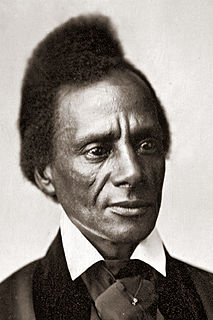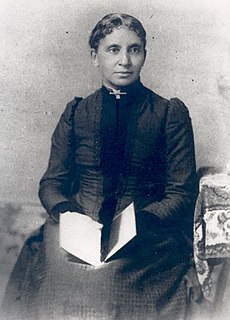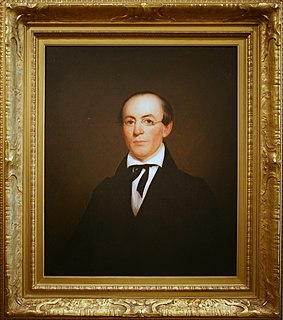Related Research Articles

William Lloyd Garrison was a prominent American Christian, abolitionist, journalist, suffragist, and social reformer. He is best known for his widely read antislavery newspaper The Liberator, which he founded in 1831 and published in Boston until slavery in the United States was abolished by constitutional amendment in 1865. Garrison promoted "no-governmentism" and rejected the inherent validity of the American government on the basis that its engagement in war, imperialism, and slavery made it corrupt and tyrannical. He initially opposed violence as a principle and advocated for Christian nonresistance against evil; at the outbreak of the Civil War, he abandoned his previous principles and embraced the armed struggle and the Lincoln administration. He was one of the founders of the American Anti-Slavery Society and promoted immediate and uncompensated, as opposed to gradual and compensated, emancipation of slaves in the United States.
The source of Garrison's power was the Bible. From his earliest days, he read the Bible constantly and prayed constantly. It was with this fire that he started his conflagration. ... So also, a prejudice against all fixed forms of worship, against the authority of human government, against every binding of the spirit into conformity with human law, – all these things grew up in Garrison's mind out of his Bible reading.

The American Colonization Society (ACS), originally known as the Society for the Colonization of Free People of Color of America until 1837, was founded in 1816 by Robert Finley to encourage and support the migration of free people of color to the continent of Africa.

The American Anti-Slavery Society was an abolitionist society founded by William Lloyd Garrison and Arthur Tappan. Frederick Douglass, an escaped slave, had become a prominent abolitionist and was a key leader of this society, who often spoke at its meetings. William Wells Brown, also a freedman, also often spoke at meetings. By 1838, the society had 1,350 local chapters with around 250,000 members.

Charles Lenox Remond was an American orator, activist and abolitionist based in Massachusetts. He lectured against slavery across the Northeast, and in 1840 traveled to the British Isles on a tour with William Lloyd Garrison. During the American Civil War, he recruited blacks for the United States Colored Troops, helping staff the first two units sent from Massachusetts. From a large family of African-American entrepreneurs, he was the brother of Sarah Parker Remond, also a lecturer against slavery.

Frances Ellen Watkins Harper was an American abolitionist, suffragist, poet, teacher, public speaker, and writer. Beginning in 1845, she was one of the first African-American women to be published in the United States.

Charlotte Louise Bridges Forten Grimké was an African American anti-slavery activist, poet, and educator. She grew up in a prominent abolitionist family in Philadelphia. She taught school for years, including during the Civil War, to freedmen in South Carolina. Later in life she married Francis James Grimké, a Presbyterian minister who led a major church in Washington, DC, for decades. He was a nephew of the abolitionist Grimké sisters and was active in civil rights.

Prudence Crandall was an American schoolteacher and activist. She ran the first school for black girls in the United States, located in Canterbury, Connecticut.
Maria W. Stewart was a free-born African American who became a teacher, journalist, lecturer, abolitionist, and women's rights activist. The first known American woman to speak to a mixed audience of men and women, white and black, she was also the first African-American woman to make public lectures, as well as to lecture about women's rights and make a public anti-slavery speech.

The Massachusetts Anti-Slavery Society, headquartered in Boston, was organized as an auxiliary of the American Anti-Slavery Society in 1835. Its roots were in the New England Anti-Slavery Society, organized by William Lloyd Garrison, editor of The Liberator, in 1831, after the defeat of a proposal for a college for blacks in New Haven.

The Massachusetts General Colored Association was organized in Boston in 1826 to combat slavery and racism. The Association was an early supporter of William Lloyd Garrison. Its influence spread locally and was realized within New England when they joined the New England Anti-Slavery Society in 1833.

The Boston Female Anti-Slavery Society (1833–1840) was an abolitionist, interracial organization in Boston, Massachusetts, in the mid-19th century. "During its brief history ... it orchestrated three national women's conventions, organized a multistate petition campaign, sued southerners who brought slaves into Boston, and sponsored elaborate, profitable fundraisers."

Sarah Harris Fayerweather was an African-American activist, abolitionist, and school integrationist. Beginning in January 1833 at the age of twenty, she attended Prudence Crandall's Canterbury Female Boarding School in Canterbury, Connecticut, the first integrated school in the United States.

Sarah Mapps Douglass was an American educator, abolitionist, writer, and public lecturer. Her painted images on her written letters may be the first or earliest surviving examples of signed paintings by an African-American woman. These paintings are contained within the Cassey Dickerson Album, a rare collection of 19th-century friendship letters between a group of women.

In the United States, abolitionism, the movement that sought to end slavery in the country, was active from the late colonial era until the American Civil War, the end of which brought about the abolition of American slavery through the Thirteenth Amendment to the United States Constitution.

John C. Bowers was an African American entrepreneur, organist and vestryman at St. Thomas African Episcopal Church, and a founding member of the first Grand United Order of Odd Fellows for African Americans in Pennsylvania. He was active in the anti-slavery movement in Philadelphia, and involved in the founding of several organizations including the Pennsylvania Anti-Slavery Society. "A fervent abolitionist and outspoken opponent of colonization, [he] was much in demand as a public speaker."

Harriet Forten Purvis was an African-American abolitionist and first generation suffragist. With her mother and sisters, she formed the first biracial women's abolitionist group, the Philadelphia Female Anti-Slavery Society. She hosted anti-slavery events at her home and with her husband Robert Purvis ran an Underground Railroad station. Robert and Harriet also founded the Gilbert Lyceum. She fought against segregation and for the right for blacks to vote after the Civil War.

Amy Hester "Hetty" Reckless was a runaway slave who became part of the American abolitionist movement. She campaigned against slavery and was part of the Underground Railroad, operating a Philadelphia safe house. She fought against prostitution and vice, working toward improving education and skills for the black community. Through efforts including operating a women's shelter, supporting Sunday Schools and attending conferences, she became a leader in the abolitionist community. After her former master's death, she returned to New Jersey and continued working to assist escaping slaves throughout the Civil War.
The Ohio Women's Convention at Salem in 1850 met on April 19–20, 1850 in Salem, Ohio, a center for reform activity. It was the third in a series of women's rights conventions that began with the Seneca Falls Convention of 1848. It was the first of these conventions to be organized on a statewide basis. About five hundred people attended. All of the convention's officers were women. Men were not allowed to vote, sit on the platform or speak during the convention. The convention sent a memorial to the convention that was preparing a new Ohio state constitution, asking it to provide for women's right to vote.

The woman's club movement was a social movement that took place throughout the United States that established the idea that women had a moral duty and responsibility to transform public policy. While women's organizations had always been a part of United States history, it was not until the Progressive era that it came to be considered a movement. The first wave of the club movement during the progressive era was started by white, middle-class, Protestant women, and a second phase was led by African-American women.

The Canterbury Female Boarding School, in Canterbury, Connecticut, was operated by its founder, Prudence Crandall, from 1831 to 1834. When townspeople would not allow African-American girls to enroll, Crandall decided to turn it into a school for African-American girls only, the first such in the United States. The Connecticut legislature passed a law against it, and Crandall was arrested and spent a night in jail, bringing national publicity. Community violence forced Crandall to close the school.
References
- ↑ Scott, Anne Firor (1990-01-01). "Most Invisible of All: Black Women's Voluntary Associations". The Journal of Southern History. 56 (1): 6. doi:10.2307/2210662. JSTOR 2210662.
- ↑ Sterling, Dorothy (1997). We are Your Sisters: Black Women in the Nineteenth Century (Revised ed.). W. W. Norton & Company. p. 108. ISBN 9780393316292.
- ↑ Sinha, Manisha (2016). The Slave's Cause: A History of Abolition. Yale University Press. p. 269. ISBN 9780300182088.
- ↑ Shaw, Stephanie J. (1999). "Black Clubwomen's Movement". In Mankiller, Wilma P.; Mink, Gwendolyn; Navarro, Marysa; Smith, Barbara; Steinem, Gloria (eds.). The Reader's Companion to U.S. Women's History (Reprint ed.). Mariner Books. p. 62. ISBN 9780618001828.
- 1 2 Adams, Catherine; Pleck, Elizabeth H. (2010). Love of Freedom: Black Women in Colonial and Revolutionary New England. Oxford University Press. ISBN 9780199779833.
- ↑ Corrigan, John; Hudson, Winthrop (2016). Religion in America (8th ed.). Routledge. p. 149. ISBN 9781317344605.
- ↑ "Colored Female Society in Salem". The Liberator. 16 February 1833. Retrieved 8 February 2017– via The Liberator Files.